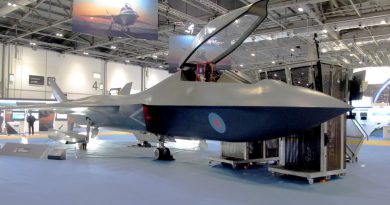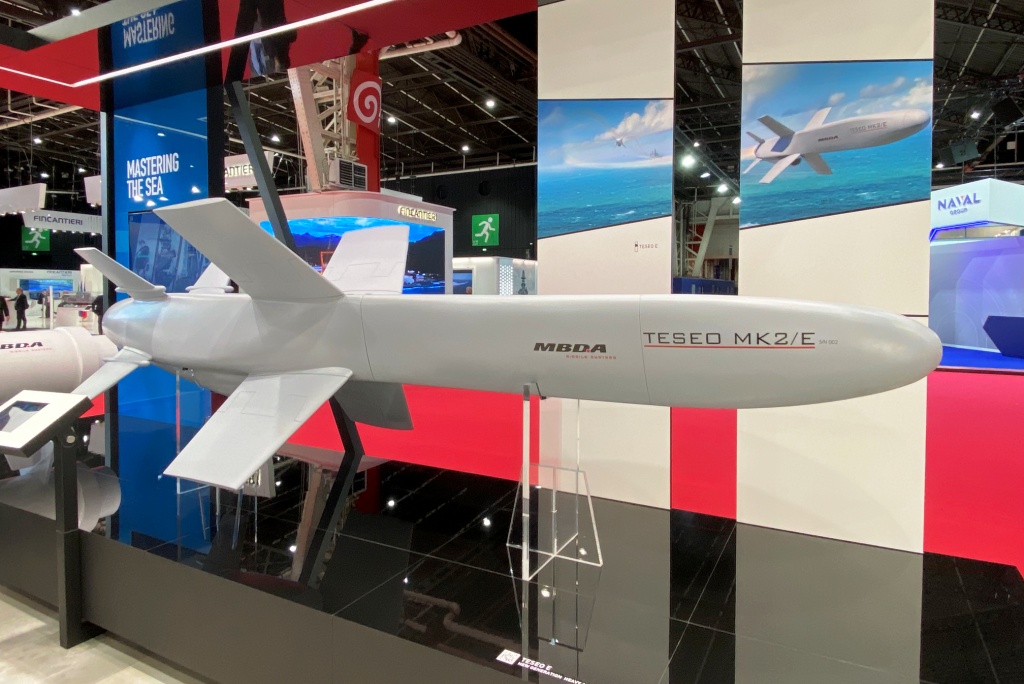
MBDA Teseo EVO: a new generation of anti-ship cruise missile
“The new Teseo EVO (Evolved) or Mk 2/E anti-ship cruise missile is the response to the operational need for shipborne and coastal defence applications, facing threats evolution within a timeframe of twenty years and more,” Marco Gelli, Teseo Mk2/E Chief Engineer and Head of New Business, Italian Anti-Ship Weapons Systems Programmes at MBDA, told EDR On-Line aside of a presentation provided on the development of anti-ship weapon systems capabilities developed by MBDA Italia at its centre of excellence of La Spezia.
The Teseo EVO is the latest addition to a family of long-range ‘heavy’ anti-ship missiles that saw its inception in the early 1970s with an industrial cooperation between Oto Melara and Matra that gave birth to the Otomat missile, as it is internationally known, over 1,000 missiles having been sold by Italy and France. The Otomat has evolved from the initial Mk 1 model to the Mk 2 of the 1980’s, the main difference laying in the re-vectoring capability that significantly extended the range. The latter design has further evolved at the beginning of the 2000’s to the latest Teseo Mk 2/A version, internationally known as Otomat Mk 2 Block IV. With a contract awarded in 2002 by the Italian Navy, the development was completed in 2007. Three were the fundamental areas of enhancement: a complete digital electronics including a new integrated inertial-GPS navigation system, new servo actuators, and a new launch system based on a new generation mission planning unit that provides enhanced mission capabilities. With a range of over 180 km provided by a turbojet engine, the high-subsonic sea-skimming missile has a navigation suite based on INS/GPS with mid-course re-vectoring (via data link) and a terminal guidance based on an X-band RF seeker. The GPS allows attacks on geographic coordinates while the advanced mission planning permits coordinated attacks on target, among others enhancements. As far as lethality is concerned, the 200+ kg warhead ensures maximum effectiveness not only against naval targets but also against more hardened land targets.
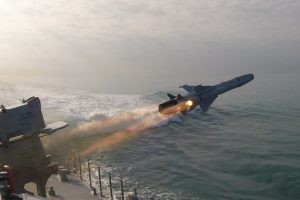
The latest Teseo Mk 2/A or Otomat Mk 2 Block IV with its new mission planning is today in service with the Italian Navy on board the 10 Bergamini-class FREMM frigates, two Horizon type DDGs and the two ageing Admiral-class DDGs. “In 2010, MBDA was awarded a feasibility contract by the service to develop a further evolved version with increased range, higher precision in the terminal phase, mission and collateral damages control, which was completed and delivered to the Navy in 2014,” the MBDA representative explains. Reduced defence budgets postponed any decision on development and procurement, but a replacement continued to be needed. “In 2017, new and more demanding requirements based on challenging operational scenarios dictated the need to develop a completely new weapon system,” which proposal was finally frozen and a contract for the development, testing, qualification and industrialization, was awarded in November 2020. This first phase is expected to be completed by late 2026/early 2027; according to the Italian MoD Multi-year Planning Document (Documento Programmatico Pluriennale, DPP) 2020-2022 and the Parliament approval procedures, it is fully funded with almost € 200 million. The follow-on phase regards the missile series production and delivery, which funding and contract is to be signed in advance to the completion of the first phase, to mitigate any potential and significant gap in the Italian Navy anti-ship capability. In the meantime a service life extension of the in-service Mk2/A is to be launched as a gap-filler solution. According to the DPP 2020-2022 the whole programme requested budget is stated at € 406.5 million, including the logistic support for the first decade.
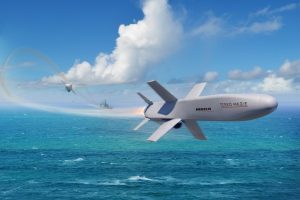
The Teseo EVO, developed according to Italian Navy requirements, will have increased survivability, being capable to penetrate both soft and hard kill advanced defences; the capability to navigate and detect autonomously its targets and discriminate them in complex scenarios; the ability to change its mission or abort it during the flight, and to operate against both sea and land targets at a range in excess of 350 km at sea-skimming level, increases its lethality while allowing collateral damage control.
The Teseo EVO is a completely new long range missile thanks to a new propulsion system, an advanced and unique dual-mode homing head and a state-of-the-art scalable warhead, and a new mission planning system, with a full mission control of the missile flight. It features a newly developed transonic airframe with advanced aerodynamic and flight controls to provide increased manoeuvrability and survivability. Slightly over 4 meters long and with a weight of 700 kg, the airframe has a forward inverted trapezoidal-shaped section while the aft part has a trapezoidal section to reduce the overall radar signature with midsection X-arranged foldable wings (1.18 x 1.18 meters when extended), a ventral inlet for the turbofan engine, and four smaller rear moving foldable surfaces and actuators to control the missile. “The design allows to further reduce the radar visibility with absorbing coating and materiel, although this is not part of the programme,” Gelli stated answering an EDR On-Line question.
The new missile airframe, slightly shorter than the Teseo Mk 2/A, comes in composite-made monolithic blocks accommodating, starting from the front, the new AESA RF Seeker, the control and navigation section also called SPICE (Sensor Power Interface and Control Equipment), the lethal package, the integrated propulsion section and the rear section with actuators and control surfaces. The new missile features a single coaxial booster which EDR On-Line understood being provided by Italian company Avio that already contributes to Aster and CAMM ER propulsion, extending the length of the munition to slightly over 4.7 meters, and adding around 100 kg. This architectural solution not only reduces the missile installation footprint but facilitates a future potential deployment from vertical launch systems.
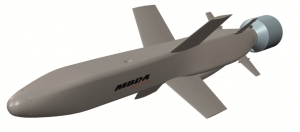
In order to obtain a high-subsonic speed and high-G terminal manoeuvrability, alongside more than doubling the range of the current Teseo Mk 2/A all at sea-skimming level, “the missile is equipped with a propulsion section,” of which no further more recent information was provided by MBDA. However, according to a disclose by the previous head of the Italian Naval Armament Directorate in late 2019, this is a low bypass turbofan which EDR understood being provided by Williams International in a package with structural fuel-tank and a new anti-g system suite designed together with MBDA.
“The Teseo EVO is equipped with an advanced guidance and navigation system centred on a new weapon control open architecture for future developments and growth potentials, together with a fully autonomous integrated INS/GPS package with radar altimeter and a two-way data link system,” the MBDA representative said. Allowing self-adapted sea skimming and fly over-land capabilities, it is equipped with a GNSS receiver with latest anti-jamming capabilities that allows using both US GPS and future EU Galileo constellations, alongside an advanced adaptive radar altimeter. “Paying particular attention to operations in congested crisis areas, which require the capability to control the missile mission up to the end of the engagement, MBDA Italia added a new miniaturized two-way data link system, relying on military satellite communications, and focused on target update and reassignment, as well as mission abort.”
The new missile terminal guidance is provided by a unique and so-far first in Europe advanced dual mode head section that includes an AESA (Active Electronically Scanned Array)-based radio frequency (RF) Ku-band seeker and an electro-optic (EO) sensor for high precision engagement. As stated last April by Lorenzo Mariani, MBDA Executive Group Director Sales and Business Development and Managing Director MBDA Italia, “the Italian Naval Armament Directorate has confirmed and activated the contractual option for the development of a new generation AESA-based RF seeker together with Leonardo to be applied to the Teseo EVO, after receiving the conclusion of a one-year feasibility study started with the missile contractual signature. With the successful completion of its development and qualification programme, in addition to adding a ‘game changer’ technology, Italy will lead a key industry capability under national sovereignty, allowing to offer the new generation seeker for multinational programmes, namely the FC/ASW (Future Cruise/Anti-Ship Weapon) and the Meteor CEP (Capability Enhancement Programme)”.
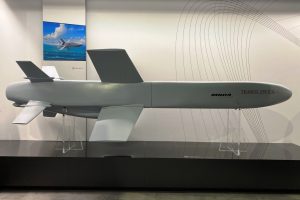
Based on MBDA Italia activities with AESA-based technology demonstrators developed by the Fusaro seeker Centre of Excellence, the company is working on the wideband digital receiver, processing back-end and ad-hoc anti-ship algorithms. MBDA Italia is the prime contractor and design authority of the new seeker while Leonardo is contributing with the AESA antenna development under the overall integration of MBDAThe wide-band Ku seeker offers significant advantages on legacy X-band ones, providing high-resolution images and advanced target classification, with growth potentials based on cognitive and deep learning algorithms, aiming point selection (APS) optimizing lethality, advanced ECCM, clutter rejection and solid state reliability, together with an architecture compatible with evolved front-ends, namely the AESA antenna. The latter offers extended acquisition range, digital beam forming and multiple target tracking, higher robustness against intentional jamming and latest generation ECCM, modulable power emission ensuring low probability of intercept and better angular accuracy, in addition to graceful degradation, while the lack of moving parts offering higher reliability.
The EO sensor installed as part of the terminal guidance package is a semi-active laser (SAL), “allowing a highly precise engagement with third parties support of both land- and littoral-based targets, hence considerably reducing potential collateral damages. The latter capability, together with the new two-way data link, provides high hit probability, even against fast moving targets at range.”
“The Teseo EVO will be equipped with a new scalable semi-piercing/high explosive warhead being developed in Italy (which EDR On-Line understood by Leonardo, as MBDA does not comment or confirm), in the same 200 kg range weight of the Teseo Mk2/A lethal package. Fitted with an impact and proximity fuse, the new insensitive warhead is however more than twice capable (vs the Teseo Mk2/A one) against reinforced concrete and steel constructions,” no more details being added. Together with the SAL guidance, the scalable warhead will contribute to plan missions in highly congested and populated areas, reducing potential collateral damages.
The Teseo Mk2/E will also have an advanced mission planning system “with 4D way-points (space and time) and programmable time on target, as well as reduced reaction time to few seconds from mission preparation to target engagement in full controlled conditions. Planned mission parameters can be modified during the mission according to the real time tactical picture”. The mission planning will also offer salvo capability with simultaneous time on target (STOT) attacks.
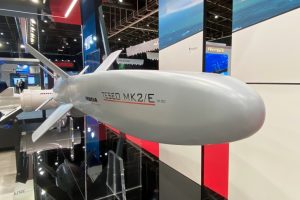
Maintaining the Otomat Mk2 Block IV
With over 140 launches and a success rate of more than 85%, the Teseo/Otomat family is today in service with 10 customers on board different classes of ships, from patrol vessels up to guided missile destroyers. MBDA maintains the capability to overhaul these missiles, including the propulsion system, and according to MBDA there is still space for additional work. MBDA is continuing to upgrade and maintain the Teseo/Otomat in its different versions, and in addition to missiles built in Italy the company recently started to deal with Otomats built in France. These were sold abroad, opening the way to additional activities and potential upgrading due to obsolescence issues. Egypt is one of the customers that recently decided to modernize at least part of its inventory of Otomats, awarding MBDA a contract for the upgrading to the Teseo Mk 2/A standard to be used on the two FREMM frigates provided by Fincantieri and potentially by coastal defence batteries. The contract also includes a limited number of new production Teseo Mk2/A that are also being supplied to other international customers.
Photos courtesy MBDA and L. Peruzzi

